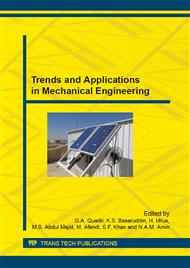p.33
p.37
p.43
p.48
p.53
p.58
p.63
p.68
p.74
Finite Element Stress Analysis of Adhesive T-Joint with Crack in Fluidization Bed
Abstract:
In this study, adhesive T-joint with crack in urea granulator fluidization bed was analyzed by finite element (FE) analysis. Objectives of this project were to examine a series of adhesively bonded T- joints with crack under mode I loading, to evaluate stress analysis of adhesive T-joint with crack at top and bottom and to identify the effective bond thickness. The path was drawn in ANSYS at the top and bottom of adhesive from side view to find which part has higher stress. The result of both paths top and bottom analysis shows the stress distribution always higher at both edges. So, the crack was inserted at interface edges and the stress distribution was evaluated. From interface edges stress distribution result of top and bottom, it shows that bottom edge has higher stress compare with top edge. The failure load analysis will compare with other analysis and experiment result. It is found that adhesive T-joint with 1.5mm is the best thickness for granulator fluidization bed application because always has higher failure load.
Info:
Periodical:
Pages:
53-57
Citation:
Online since:
August 2015
Authors:
Keywords:
Price:
Сopyright:
© 2015 Trans Tech Publications Ltd. All Rights Reserved
Share:
Citation:


